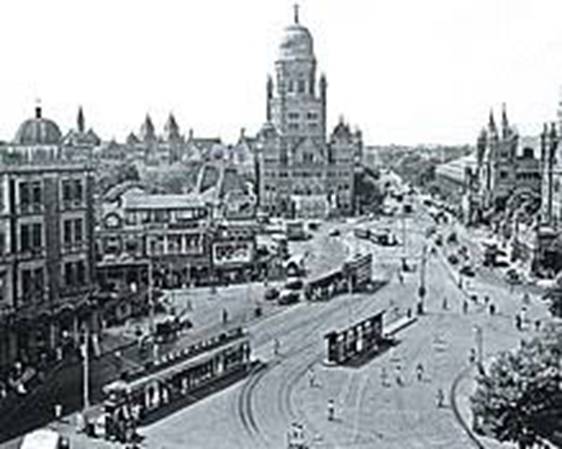
Wikipedia
The Fascinating Story of Bumbye (Bombay/Mumbai)
By Dr Khalid Siddiqui
Ohio

In the early 16th century Bumbye was ruled by Bahadur Shah of Gujarat. He became worried by the growing power of the Mughal Emperor Humayun. To counter the Mughal threat, he entered into a defense treaty with the Portuguese Empire on December 23, 1534, mediated by the envoy from the Ottoman sultan, Suleiman the Magnificent. As per the treaty, the seven islands of Bombay and the nearby strategic town of Bassein were offered to the Portuguese. The Portuguese took over the territories on October 25, 1535.
On August 28, 1608, Captain William Hawkins of East India Company (EIC) became the first commander of an EIC vessel to set foot on Indian soil. He noticed that the Mughals kept a 4 million-man army. Hawkins made it clear to the Directors of EIC that the force of arms was not an option when dealing with the mighty Mughal empire, and to do trade successfully in India they would need partners and permissions, instead. It took Hawkins one year to meet Jahangir in Agra. Jahangir showed no interest in any discussion on the subject of trade, and sent him back home with the gift of an Armenian Christian wife.
EIC then persuaded King James I to send a royal envoy to Mughal India. Thus, Sir Thomas Roe arrived in India in 1615. Roe brought many gifts for Emperor Jahangir including several crates of red wine. He held several inconclusive meetings with the Emperor. After staying three years in India, he was able to obtain only one permit from Jahangir to set up a trading station in Surat. Jahangir didn’t think much of Roe as he didn’t even mention his name in his memoirs.
So for the first time, EIC established a trading station on the western coast of India. The EIC employees, however, were very unhappy to be posted to Surat because it was a very small, boring town. They resorted to setting up whorehouses and arrack drinking joints. (Arrack is a local drink made from the fermented sap of coconut flowers or sugarcane.) Fully drunk they would cause disturbances in the town. The local population wanted them out, but EIC didn’t want to lose its foothold on the west coast. So, EIC somehow hung in there although the situation was very tense.
On May 21, 1662, Catherine of Braganza, who was the daughter of King John IV of Portugal, married King Charles II of England, Scotland and Ireland.
The port of Tangier and the seven islands of Bumbye were given by the king of Portugal as part of Catherine’s dowry to Charles. The location of Tangier was well-known, so the takeover was easy. (Tangier was reoccupied by Morocco in 1684.) However, in London there was much confusion about the location of Bumbye, as the map that accompanied Catherine’s marriage contract went missing en route. The Royal Palace didn’t feel it proper to ask the Portuguese authorities about the location of Bumbye. It was decided to inquire The Lord High Chancellor who would, it was believed, know the location of Bumbye. He didn’t know either, but he presumed, somewhat logically, that as Brazil was Portugal’s largest colony, it had to be somewhere near Brazil! So, the ships were sent to find the islands along the Atlantic coast of Brazil!
It took several months to locate Bumbye correctly. In September 1662, Sir Abraham Shipman finally arrived with 450 men to claim Bumbye for the British. There he met a surprise. The Portuguese government had not sent instructions to the Portuguese governor to hand over the islands to the British. The Portuguese governor didn’t believe in Sir Abraham’s story. He suspected it to be a part of a plot by the British to occupy the Portuguese territory. So, the English party was imprisoned in a barren island to the south. It took another three years to get things straightened out. By 1665, when the island was finally handed over to the British, 336 members of the British party, including Shipman, had died from fever, starvation, and heatstroke.
Eventually, Bumbye turned out to be the best natural harbor in South Asia. It quickly eclipsed Surat as the main center of EIC operations on the west coast. All those rowdy EIC employees from Surat were moved to Bumbye. Later it became EIC’s major naval base in Asia.
Thus, Bumbye became the first British territory in India where EIC had a permanent settlement. EIC, though, had two other permanent settlements, Madras and Masulipatnam, but those were within the territories of Vijayanagara Empire and Golconda Sultanate, respectively. Although EIC did have trading stations within Mughal India in Surat, Hougli, Kasimbazar and Patna, its first permanent settlement within Mughal India was established in Bengal in 1793 granted by Emperor Shah Alam II.
Note: Catherine of Braganza is credited with making tea fashionable among the aristocratic women of England. The NY city borough, Queens, was named after her; and Kings County in NY was named after her husband, King Charles II.

